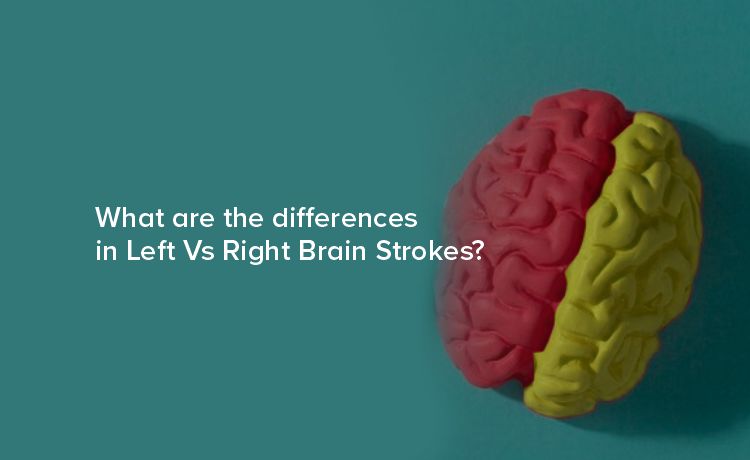
What are the differences in Left Vs Right Brain Strokes?
Strokes are among the leading causes of disability in adults, but did you know that the effects of a stroke can differ dramatically depending on which side of the brain is affected?
What Happens When a Stroke Occurs?
A stroke occurs when blood flow to a part of the brain is obstructed, either by a blockage (ischemic stroke) or by a burst blood vessel (hemorrhagic stroke). This interruption deprives brain cells of oxygen, causing them to die. The location of this blockage or burst can drastically change the outcomes and symptoms.
When we talk about left-brain and right-brain strokes, we're referring to which hemisphere of the brain the stroke has impacted. Each hemisphere controls different functions and areas of the body, setting the stage for unique post-stroke experiences.
Anatomy of the Brain Functions of the Left and Right Hemispheres
The brain is divided into two hemispheres, the left and the right, each responsible for different functions. While they work together to keep us functioning normally, they also have distinct roles.
Left Hemisphere Functions
- Language skills, including speech and writing
- Logical thinking and reasoning
- Numbers and mathematical calculations
Right Hemisphere Functions
- Spatial awareness and perception
- Recognizing faces and interpreting facial expressions
- Creativity and imagination
Symptoms of a Left-Brain Stroke
When a stroke occurs in the left hemisphere, it primarily affects the right side of the body and various cognitive functions. Here's what you might experience:
- Physical Symptoms
- Right-sided weakness or paralysis
- Difficulty walking or maintaining balance
- Loss of coordination on the right side
- Cognitive and Emotional Symptoms
- Aphasia (difficulty with speaking, reading, or writing)
- Difficulty understanding language
- Impaired logic and problem-solving skills
- Increased anxiety and depression, as the left hemisphere plays a role in mood regulation
Symptoms of a Right-Brain Stroke
A right-brain stroke manifests differently, affecting the left side of the body and impacting more creative and spatial functions. Symptoms often include:
- Physical Symptoms
- Left-sided weakness or paralysis
- Difficulty walking or maintaining balance
- Loss of coordination on the left side
- Cognitive and Emotional Symptoms
- Neglect of the left side of the body or space (left-side neglect)
- Difficulty recognizing faces or objects (prosopagnosia)
- Impaired attention and perception
How Doctors Determine Stroke Location?
To identify whether a stroke has affected the left or right hemisphere, doctors use various diagnostic tools:
Neurological Exams
A doctor will assess motor skills, sensory responses, and cognitive functions. The pattern of symptoms can often indicate which hemisphere is affected.
Imaging Tests
CT scans and MRIs provide detailed images of the brain, helping doctors pinpoint the stroke's location and severity.
Blood Tests
These can help identify underlying conditions contributing to the stroke, such as high cholesterol or diabetes, and inform treatment plans.
Treatment Options for Left-Brain Strokes
Treating a left-brain stroke involves a combination of medication, therapy, and lifestyle changes. Here's what to expect:
Medications
- Thrombolytics to dissolve clots
- Antiplatelets and anticoagulants to prevent further clotting
- Antihypertensives to manage blood pressure
Rehabilitation
- Speech therapy to improve language skills
- Physical therapy to regain strength and mobility on the right side
- Cognitive therapy to enhance reasoning and problem-solving abilities
Lifestyle Adjustments
- Adopting a heart-healthy diet
- Engaging in regular physical activity
- Avoiding smoking and excessive alcohol consumption
Treatment Options for Right-Brain Strokes
Treating a right-brain stroke also involves a multi-faceted approach, focusing on restoring physical and cognitive functions:
Medications
Rehabilitation
- Occupational therapy to improve daily living skills
- Physical therapy to regain strength and coordination on the left side
- Cognitive therapy to enhance attention and spatial awareness
Lifestyle Adjustments
- Encouraging social interaction to combat isolation
- Incorporating activities that stimulate the right brain, such as art or music therapy
- Regular follow-ups with healthcare providers
Long-Term Outlook and Recovery
Recovery from a stroke is a long-term process, and the outlook can vary based on several factors:
Factors Influencing Recovery
- Severity of the stroke
- Promptness of medical intervention
- Patient's age and overall health
- Support system and rehabilitation efforts
Milestones and Progress
- Initial improvements usually occur within the first few months
- Continued progress can be seen up to two years post-stroke
- Ongoing therapy and lifestyle changes can significantly enhance quality of life
Preventing Future Strokes
Preventing a recurrence is crucial for stroke survivors. Here are some proactive steps:
- Medical Interventions
- Regular check-ups and monitoring
- Medications to manage underlying conditions
- Surgical procedures, if necessary, to remove blockages
Lifestyle Choices
- Maintaining a balanced diet rich in fruits, vegetables, and whole grains
- Regular exercise, such as walking or swimming
- Avoiding smoking and limiting alcohol intake
Stress Management
- Practicing mindfulness and meditation
- Seeking support from friends, family, or support groups
- Engaging in hobbies and activities that bring joy and relaxation
Practical Assistance
- Help with daily tasks, such as cooking and cleaning
- Accompany them to medical appointments
- Assist with exercises and therapy routines
Conclusion
Understanding the differences between left-brain and right-brain strokes is crucial for effective treatment and recovery. By recognizing the unique symptoms and challenges associated with each type of stroke, patients and caregivers can better navigate the path to recovery.

Author Bio
Dr A Praveen
Medical Oncology
medical oncologists in American Oncology Institute in Gurugram
Dr (Brig) Anil Kumar Dhar is one of the top medical oncologists in Gurugram. He has a vast experience of more than 30 years in the field of Medical oncology. He his specialised in treating leukemia,lymphoma, hematological oncology and other complex oncology cases . He is also specialised in Bone Marrow Transplantation (BMT) treatment. He is working as a Senior Consultant, HOD, Medical Oncologist in American Oncology Institute, Gurugram.
